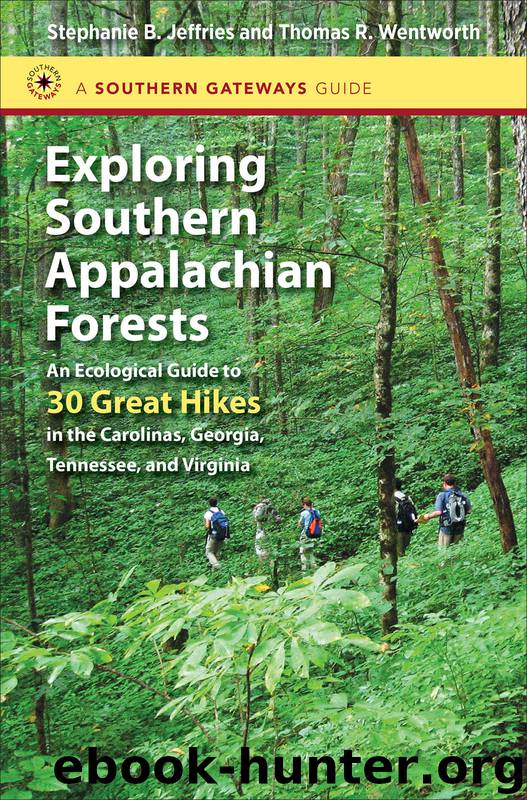Exploring Southern Appalachian Forests by Stephanie B. Jeffries

Author:Stephanie B. Jeffries
Language: eng
Format: epub
Publisher: The University of North Carolina Press
Published: 2014-03-14T16:00:00+00:00
The larva of a pipevine swallowtail butterfly feeds on a leaf of its host plant, the Dutchman’s pipe. High diversity of tree species in Joyce Kilmer Memorial Forest provides a variety of habitat niches and thus supports high faunal diversity.
When you return to the memorial plaque, take a break and consider your lengthy list of tree species. The last time we hiked here, we encountered 30 different tree species in a 2-hour circuit of the loop trails. Magnolias, tulip-trees, hemlocks, ash, beech, maples, hickories, oaks, dogwood, hemlock, birch, silverbell, basswood, and many others populate this rich cove forest. If you have visited other forests in the southern Appalachians, you will recognize that the diversity of trees here is quite impressive. Indeed, rich cove forests in the southern mountains harbor more tree and herbaceous species than any other temperate forest type in North America.
Continue your hike, completing the second half of the lower Memorial
Eastern North American–Eastern Asian Connections
Why do rich cove forests harbor so many species in a relatively small area? Certainly environment plays a role. Soils are deep, moist, and nutrient-rich, meeting the needs of a wide range of species. Summers are warm and mild, and the winters are not as harsh as they are at higher elevations or higher latitudes. The topography of the cove itself protects plants from the drying effects of high winds and excessive sun exposure found on the upper slopes, ridges, and summits above the cove. Further exploration of the processes maintaining high herbaceous diversity is to be found in the sidebar “Wildflower Diversity in Temperate Forests,” in hike 6 (Station Cove Falls). However, a more fruitful question at this point might be “Where did all these species come from?” This is a question relevant not only for rich coves but for all the natural communities of the southern Appalachians.
The answer takes us back to the later part of the Mesozoic Era, the Age of Reptiles, when dinosaurs roamed the earth. The ancestors of the tree species you see today were already evolving and diversifying in subtropical and warm-temperate climatic regions that were widespread at the time. The dinosaurs became extinct at the end of the Mesozoic (65 million years before the present), but subtropical and warm-temperate forests flourished throughout much of the next great (and present) era, the Cenozoic, the Age of Mammals.
Early to mid-Cenozoic fossil records from across much of North America, Europe, and Asia indicate that such forests were widespread for many millions of years, and they harbored the ancestors of the tree species we see today in rich cove forests of the southern Appalachians. But later in the Cenozoic, climates cooled worldwide, culminating in the Ice Age (Pleistocene Epoch) of the past 2 million years. Many parts of the subtropical and temperate zones also became drier, leaving fewer places where species-rich, warm-temperate forests could flourish. Today, these species-rich, warm-temperate forests are found primarily in eastern North America, in eastern Asia, and to a lesser extent, in western North America and western Europe.
Download
This site does not store any files on its server. We only index and link to content provided by other sites. Please contact the content providers to delete copyright contents if any and email us, we'll remove relevant links or contents immediately.
The Lonely City by Olivia Laing(4120)
Animal Frequency by Melissa Alvarez(3755)
All Creatures Great and Small by James Herriot(3516)
Walking by Henry David Thoreau(3234)
Exit West by Mohsin Hamid(3183)
Origin Story: A Big History of Everything by David Christian(3139)
COSMOS by Carl Sagan(2950)
How to Read Water: Clues and Patterns from Puddles to the Sea (Natural Navigation) by Tristan Gooley(2855)
Hedgerow by John Wright(2776)
The Inner Life of Animals by Peter Wohlleben(2766)
Origin Story by David Christian(2683)
How to Read Nature by Tristan Gooley(2665)
Project Animal Farm: An Accidental Journey into the Secret World of Farming and the Truth About Our Food by Sonia Faruqi(2661)
How to Do Nothing by Jenny Odell(2645)
A Forest Journey by John Perlin(2588)
Water by Ian Miller(2584)
The Plant Messiah by Carlos Magdalena(2454)
A Wilder Time by William E. Glassley(2364)
Forests: A Very Short Introduction by Jaboury Ghazoul(2335)
